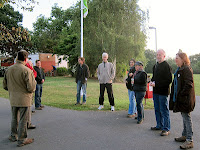It was still dark when I arrived at the Bothy at 5am, but the birds were already tweeting the good news to each other. Not only was dawn about to break, but a group of humans was gathering below to listen to their song. Chris McGaw of the Lewisham Rivers and People Project was already there (as befits a leader) and eventually another six people materialised out of the gloom. Some of them were even awake. This was not a bad total considering the lousy weather in the days leading up to the walk.
As it happened, we were lucky. Apart from a couple of brief showers, the rain held off and Chris led us around both Hilly Fields and Brockley Cemetery, using his excellent birdsong ID skills to provide a running commentary. In Hilly Fields, we saw and/or heard: Great Tits, Blue Tits, Blackbirds, Robins, Wrens, Blackcaps, Goldfinches, Chaffinches, Crows, Woodpigeons, a Great Spotted Woodpecker, a Magpie, a House Sparrow and a Ring-necked Parakeet.
The highlight for me was the superb views of the male Woodpecker in a tree next to the tennis courts. We could clearly see all the colours of its plumage and its vigorous movements around the tree trunk, climbing down backwards at one point. It was also good to see and hear the reappearance of Goldfinches in the trees around Prendergast School after a few weeks of absence (no doubt, due to the mating season).
After crossing Adelaide Avenue, we came across a pair of Mistle Thrushes - one quite young - on a lawn belonging to the Ivy Road flats. Again, we had really good views of them and of the young one in particular who didn't quite know what to make of all the attention.
We arrived at the gates of Brockley Cemetery at 6.25 am, well before official opening time, but our leader magicked a key out of his trouser pocket and let us in via the Lodge garden. As you might expect, it was pretty quiet - apart from the birds. During our walkabout, we saw and/or heard a very vocal Song Thrush, a Chiffchaff, a Dunnock, Long-tailed Tits, a Greenfinch, a Green Woodpecker, a Jay and a Goldcrest in addition to some of the species already seen in Hilly Fields. And a couple of members of the group caught a brief glimpse of a Sparrowhawk as it flew across the path behind us in the Wilderness Area.
We had good views in particular of the Chiffchaff and the Goldcrest, although as the latter was high in a tree, we couldn't really see its striking black and yellow crown. The Goldcrest is the UK's smallest bird, approx 9 cm long and 4.5-7.0 g. in weight.
After that, it was time to head home after thanking Chris for leading the walk and sharing his knowledge and experience. I had almost reached my street when the rain started bucketing down again. But was I downhearted? No. Just in need of strong coffee and lots of it.
Dawn Chorus Walk: 4 May
And if you missed our walk, Chris McGaw is leading another Dawn Chorus Walk on Friday 4 May - this time along the Riverview Walk which follows the Pool and Ravensbourne rivers. Meet at 5.00 am outside the Sainsbury Savacentre at Bell Green. More details in the Lewisham Rivers and People programme here: http://natureconservationlewisham.co.uk/rivers-people/




.jpg)





.jpg)


.jpg)







.jpg)
.jpg)

